Black-tailed Godwit - immature, 8th
Hobby - juvenile (11th) and adult (15th)
Spotted Flycatcher - 8 to 12 birds on six dates
Peregrine - one on 17th
Red-crested Pochard - two (from Aug) to at least 19th
Egyptian Goose - two on 13th, and again on 19th & 26th
Sandwich Tern - four over, 3rd
Rook - two on 29th
productive visible migration - inc. pipits, larks, wagtails, uncommon finches and waders
All records refer to Stoke Newington Reservoirs unless otherwise stated
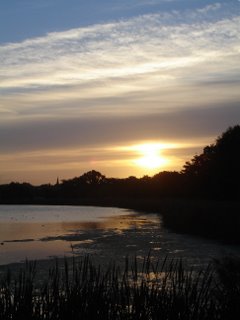
Almost the entire month (but for occasional brief showery periods) was fine, dry and mild - indeed often very warm, with the now almost expected indian summer providing pleasant watching conditions and extending the season even longer than in recent years. Winds during the period were rarely strong, and almost without exception from the southerly half of the compass.
Time spent on patch - mainly at the reservoirs, but also in Clissold Park and Abney Park Cemetery - was stepped up during the period, and several hours were dedicated to observations almost every day. Watching at the reservoirs usually began around dawn - often the case anyway, but earlier starts being even more justified on account of the time of year - and time spent in Clissold Park was either at dawn (for grounded migrants, before too much disturbance) or during the day (for flyovers).
Activity during this period was rich and varied, with a strong cast of migratory species and some real surprises. Most notable records, as expected, came from the reservoirs, with a good mix of grounded migrants, waterfowl and flyovers/visible migration.
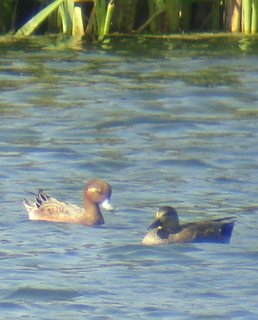
(Wigeon & Gadwall, 21st)
Wildfowl numbers (and the list of species) continued to grow, as birds from further north and the continent used the reservoirs as a moulting site and refuelling stop. September peaks included: Common Pochard, 61 on 5th; Northern Shoveler 32 on 26th; Gadwall, 40 on several dates; Tufted Duck, 80 on 6th; Ruddy Duck - c30 on many dates; Mallard, 27 on 15th.
Uncommon and/or seasonal wildfowl records were represented by several species. The first Wigeon arrived on the 12th, with a group of seven on the ER; thereafter, numbers varied as new birds arrived and others departed, with eight on 13th, nine on 15th, seven on 17th, eight on 19th, 13 on 21st, six on 23rd, five on 26th (including two new males), and one on 29th.
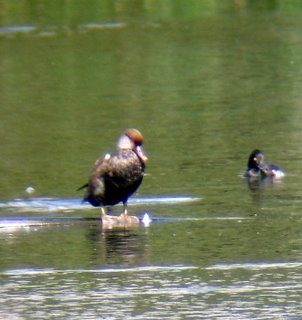
(imm. male Red-crested Pochard, 9th)
Red-crested Pochards continued their regular-as-clockwork autumnal presence, with two (immature male and female) arriving in the third week of August and remaining until at least 19th (the male being present for much of his moult from female-type plumage into less cryptic dress). With a few occasional exceptions in the winter, almost all records of this species in recent years fall within a short window of mid-August to late September.
Long overdue considering the species status in London, Egyptian Goose finally made it onto the local list, with a pair frequenting both reservoirs on the 13th, and again on the 19th and 26th. Numbers of Canada Geese swelled to record proportions, as the WR became a popular roosting site - dozens were counted leaving the site at dawn on several occasions, with top counts of 49 on 15th and 19th.
Great Crested Grebes were still attempting to breed during the last week of the month, with both birds occupying a freshly built nest; other individuals were often present, including odd juveniles on both reservoirs. Little Grebes maintained an unusually strong presence on the ER, with double figures on most days; a record 18 were recorded on the 21st. Young were still being shepherded away from gulls as late as the end of the month.
Grey Heron and Cormorant numbers swelled during the month, with often as many as 10 of the former and 40 of the latter recorded.
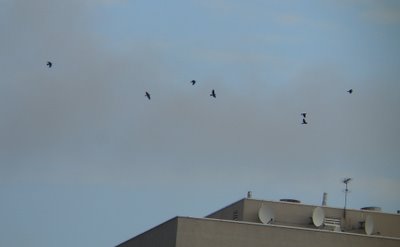
(Jackdaw passage, 29th)
Raptors were well represented, with Sparrowhawks being omnipresent, especially at the reservoirs; three or four individuals were often seen, and although local birds can't be ruled out, migrants were almost certainly involved. Kestrels were recorded fairly regularly, and a Peregrine early on the morning of the 17th was, perhaps surprisingly, the first record for several months.
The choice bird of prey of the month was undoubtedly Hobby; a juvenile on the 11th and an adult on the 15th both performed beautifully, giving great views over the ER. Both were recorded before 0900hrs, and neither loitered for longer than a couple of minutes.

The high water levels on both reservoirs - and the overgrown state of the WR's perimeter - meant hopes of passage waders dropping in, however briefly, were lower than ever. However, the bird of the month - and one of the most unexpected records in recent times - was an immature Black-tailed Godwit, which came in low from the west, calling loudly, just after dawn on the 8th.
Much to frustration of both the observers and the bird, there was nowhere for it alight; however, four or five exploratory laps low over the ER (with half-hearted attempts to land in several unsuitable corners) were completed before the bird departed to the south-east. The only other wader record for the month came with two Common Snipe, flying fairly high and north, on the morning of the 15th.


(Sedge Warbler, 23rd)
Gull numbers, and species, slowly increased as the month wore on, with Black-headeds dominating (as usual at this time of year); a handful at the beginning of the month became 15 to 30 by mid-month, and a peak of 55 on 21st was typical for the period. Lesser Black-backed Gulls were omnipresent in small numbers, usually between three and eight, and one to three Herring Gulls were recorded on most occasions.
An especially early Common Gull - an adult - was present on the gull pipes of the ER on 8th, and 2nd winters were briefly present (in the same place) on 19th and 29th. Tern passage was almost non-existent, with two Commons on 10th and, surprisingly, four Sandwich Terns on 3rd.
Woodpigeon passage was regular and prolonged during the month, with up to 200 recorded on several dates late in the month; Stock Doves also passed through in small numbers, with a peak of six on 21st. Late Common Swifts were recorded on 5th (three) and 6th (one over Clissold Park). Kingfishers were ubiquitous, with two or three seen on most visits; ditto Great Spotted and Green Woodpeckers, with at least one or two of each usually present at all sites.
Hirundines ebbed and flowed throughout the month, although with few defined peaks, and double figure counts of any of the three species were uncommon. In contrast to last September, Barn Swallows were often the most numerous, with several counts of between 10 and 15, with a peak of 19 on 19th.

(Carrion Crow & Magpie harrassing Sparrowhawk, 29th)
House Martins were uncharacteristically scarce, with single figures at best, but for an isolated peak of 65 (also on 19th). Sand Martins were also regular but hardly numerous. (All three species were recorded on 29th, hopefully not the last of the autumn).
Skywatching for flyovers was, however, very productive. Pipits, wagtails, finches and larks complimented movements of Woodpigeons (and Starlings), and early morning sessions at the reservoirs were often rewarded with the sight and calls of relatively uncommon migrants overhead.
Species which were previously considered scarce or vagrant were encountered (through patience, and often blank hours) performing visible migration on many occasions. Generally speaking, the most productive time was from about half an hour after dawn until around 0900, and often depended on conditions; some days were blank, others were enlightened by quality, quantity or both.
Two Skylarks over on the 19th were the first of the year, but the most impressive counts involved Meadow Pipits. From the first autumn record (of three on the 15th) to the month's end, a total of 175 were recorded, eclipsing counts of previous years by many times. Peaks of 73 on 23rd and 55 on 26th were indicative of strong movements throughout the last fortnight.
Tree Pipits, previously barely annual in the area, totalled three for the month; all records, on 15th, 17th and 19th, involved calling flyovers. Wagtails of all three British species were also involved in movements; four Yellows were perhaps the highlight, with singles on 11th, 19th, 23rd and 26th.

(Spotted Flycatcher, 5th)
Both Pied and Grey Wagtails were also on the move, although counts were blurred by 'resident' birds - several of each being normally present around the reservoirs; peaks of 10 Pieds (on 23rd) and six Greys (on the 8th) probably reflected conservative counts, and both species were seen flying over at height on many occasions.
A single Northern Wheatear flew west over Clissold Park on 8th.
Robin numbers swelled during the middle of the month especially, with around 15 often recorded, usually coinciding with small influxes of Blackbirds, up to 40 of which were seen on several dates.
Song Thrushes, a fairly scarce local bird with only one confirmed breeding pair on site, also became more numerous, with up to 20 birds on several dates mid-month. Mistle Thrushes also became far more evident, with - in common with last year - presumably the same flock of up to 25 birds pre- and post-roost at the northern edge of the site.
Warblers, while rarely present in any great volumes (unlike last autumn's heavy influxes), kept things interesting, with all the common species moving through. Sedge Warblers, absent for the first ten days of the month, unexpectedly reappeared from the 11th; one's and two's were seen on several dates, with a peak of three on 23rd. One sang at dawn on 15th, and the last record was of two on 26th.

(Egyptian Geese, 13th)
Reed Warbers maintained a constant presence, with five to ten often recorded, and a peak of 12 on 12th; fewer were seen at the end of the month, but again, several birds sang on warm, clear mornings. All four Sylvia warblers were recorded, with Blackcaps predictably the most evident. One or two were seen on most occasions, with peaks of five on 5th and 8th, and three on 23rd.
A single Garden Warbler was at the ER on 13th, again, surprisingly in full song for much of the day; Lesser Whitethroats were recorded on 17th (one) and 19th (two), and a single Common Whitethroat was seen on the 5th.
Willow Warblers peaked in the first week of the month, with 18 on 5th and 12 on 8th, with numbers then decreasingly rapidly; singles were seen on most occasions thereafter, with a last record of one on 23rd.
Chiffchaffs, as expected, peaked later, and were still being recorded in fairly good numbers at the end of the month. Four to ten were not unusual throughout, with peak counts of 20 on 8th (16 at ER, 4 in CP) and 12 on 15th. Both species, once again, were singing on many occasions.
Goldcrests were typically seen or heard on about every other visit, with juveniles present on several dates mid-month. Spotted Flycatchers were a real highlight of the month, with at least eight (probably 10-12) birds recorded between 4th and 12th. Favoured sites included the deer enclosure and lakeside areas in Clissold Park, and the southern and north-eastern areas of the East Res.


(Hobby, 15th)
Tit flocks around the sites, especially along the New River east, predictably grew in strength through the month, with up to 30 Long-tailed Tits along with many Blues and Greats. Flocks often contained Phylloscopus and odd Sylvia warblers (but as yet, no Treecreeper or Firecrest....)
Corvid movements were especially evident during the last week of the month, by which time Jays numbered up to ten on several visits in and around the Oaks of the ER, and also in Abney and Clissold. Counts of Carrion Crows began to build mid-month, with up to 50 passing over on several days by the last week.
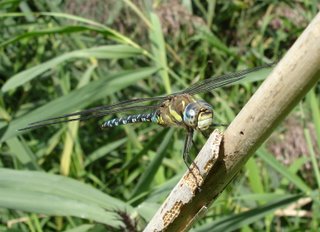
(Migrant Hawker, 9th)
Jackdaws, a scarce but regular autumn migrant, were recorded on 26th (six, west) and 29th (eight, west); two Rooks - a veritable vagrant in the area - were a pleasant surprise, also on 29th.
Starling numbers rose in accordance, often coinciding with high counts of Woodpigeons and Carrion Crows; over a hundred a day wasn't unusual by the last ten days of the month. House Sparrows remain omnipresent along the eastern fringe of the ER, where the flock presently numbers around 25.
Finches provided a few hard-earned highlights during visible migration watches (although hopefully October will provide more); Greenfinches were the commonest, with peaks of 60+ on 19th, 50 on 21st and 29th, and a 'local' flock of around 25 present from mid-month. Chaffinches were also on the move, with double figures over on some days, and more birds present around the ER by the end of the month.

(Spotted Flycatcher, 5th)
Siskins featured comparatively well, with two on 5th, eight on 17th, seven on 19th, two on 26th and one on 29th (mostly overhead calling but occasionally grounded), while Lesser Redpolls were recorded on 26th (two by the ER) and 29th (one over). Two records of Linnets - a locally rare bird - were encouraging, with one over CP on 8th, and three over the ER on 19th.
Escapes: A blue-morph Budgerigar flew around the perimeter of the ER on 21st.
Mark